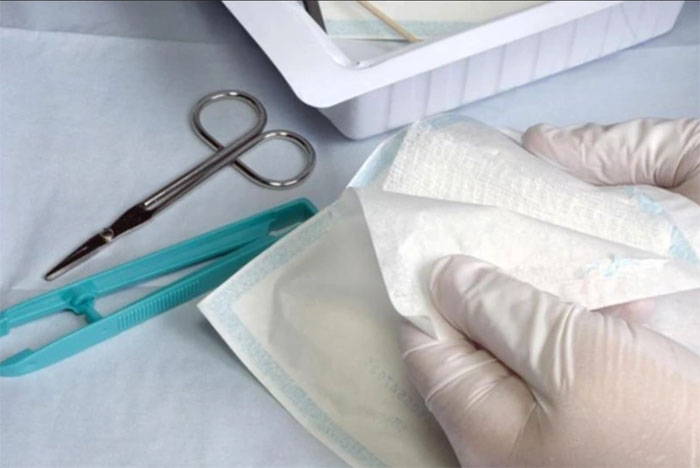Vietnamese scientist finds a way to treat wounds from freshwater fish scales
Using the scales of freshwater carp species native to Vietnam, Dr. Nguyen Thuy Chinh has successfully researched how to extract "clean" collagen, which has been successfully tested for wound treatment.
In addition to its beauty benefits, collagen has long been widely used in biomedical applications, such as wound dressings. However, most of the popular products on the market today are derived from mammals such as pigs, cows and sheep. with somewhat limited clinical applicability, as well as hidden concerns. on the risk of transmission of infectious diseases from mammals.

Wound dressings contain collagen to help speed up wound healing.
Faced with this fact, Dr. Nguyen Thuy Chinh and colleagues at the Institute of Tropical Technology (Vietnam Academy of Science and Technology) have successfully researched the extraction of collagen from freshwater fish scales, and successfully tested to treat wounds. for the mouse.
"Fish scales have a relatively abundant source of collagen and solve most of the problems of collagen from mammals" - Dr. Nguyen Thuy Chinh said. In the preliminary processing process, fish scales are considered waste products of residential markets or processing factories. With the annual production of tilapia in Vietnam about 50,000 tons (accounting for 2.2% of the total aquaculture production) and hundreds of thousands of tons of carp species, this study has made use of waste products, limiting the risk of harmful effects. environmental pollution has just obtained a source of good quality collagen for the biomedical field.
The difference of this research topic is that the scientists used the scales of freshwater carp species originating from Vietnam, not saltwater or brackish water fish like previous studies have had. Not only does the biodiversity in each location affect the maturation of freshwater fish in different ways, but different temperatures also lead to different composition and texture of fish scales.

Close-up of 3D printing process of collagen film from fish scales as hemostatic material.
The representative of the research team said that the processing of fish scales to collect collagen was carried out in a thermostatic tank maintained at 4 degrees Celsius. The obtained collagen had a fibrous structure with a fiber diameter of 0.5 -1 micrometer, collagen fibers gather into fiber bundles, 2.5-4 micrometers in size.
From the collagen obtained, the research team mixed it with the active ingredient ginsenoside Rb1 - a chemical compound of the ginsenoside family found in the plant genus Panax, with anti-inflammatory, anti-allergic effects and polyphenols from yellow flower tea. and then inserted into the cylinder of the 3D printing device to print the product into a film that can be applied to the wound.
Experimenting with large buttock muscle injuries in rats was conducted at the Military Medical Academy, the results obtained made the research team realize a clear effect of collagen obtained from fish scales. The average hemostasis time of the biofilm was 104 ± 16.7 seconds, lower than that of using conventional gauze to stop bleeding (p<0.05).
The above results are the initial results for Dr. Nguyen Thuy Chinh and colleagues continue to think about future studies. One of the research directions that she is interested in is that this product has potential not only for skin wounds but also for internal wounds in the body.
- The female doctor created hemostatic material from fish scales
- The scales are as hard as the armor of an Amazon arowana
- Detection of wound healing of collagen in fish scales
- What is Sam fish?
- Top 10 rare and expensive fishes in Vietnam
- Things you do not know about marine fish statues
- Horror with 'freshwater monsters' riverbed
- Vietnamese scientist was honored by the President of Poland
- Sea fish are descendants of river fish?
- Freshwater fish bears the name of President Obama
- Detected 112-year-old freshwater fish in the US
- Detecting pirate fish 'equipped' chemical weapons
 Green tea cleans teeth better than mouthwash?
Green tea cleans teeth better than mouthwash? Death kiss: This is why you should not let anyone kiss your baby's lips
Death kiss: This is why you should not let anyone kiss your baby's lips What is salmonellosis?
What is salmonellosis? Caution should be exercised when using aloe vera through eating and drinking
Caution should be exercised when using aloe vera through eating and drinking